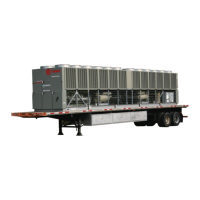51
RLC-SVX02G-E4
Installation – Electrical
Optional External Chilled-
Water Set Point (ECWS):
The CH.530 provides inputs that
accept either 4-20 mA or 2-10 V (dc)
signals to set the external chilled-
water set point (ECWS). This is not a
reset function. The input defines the
set point. This input is primarily
used with generic BAS (building
automation systems). The chilled-
water set point can also be changed
through Tracer.
The chilled-water set point may be
changed from a remote location by
sending either a 2-10 V (dc) or
4-20 mA signal to the (A2-1) module.
2-10 V (dc) and 4-20 mA each
correspond to a 10°F to 65°F
[-12°C to 18°C] external chilled-water
set point.
The ECWS LLID only reports either
current or voltage. The value can be
considered either.
If the ECWS LLID develops an open
or short, the LLID will report either a
very high or very low value back to
the controller. This will generate an
informational diagnostic and the
unit will default to using the Front
Panel Chilled-Water Set Point.
TechView is used to install or
remove the External Chilled-Water
Set Point option as well as a means
to enable and disable ECWS.
The following equations apply:
Voltage Signal Current Signal
As generated from external source V (dc) = 0.1455*(ECWS)+0.5454 mA = 0.2909(ECWS)+1.0909
As processed by CH.530 ECWS = 6.875*(V (dc))-3.75 ECWS=3.4375(mA)-3.75
ECWS vs Input (VDC) ECWS versus Input (mA)
A = ECWS
B = Input (VDC)
C = Input (mA)
= Out of range diagnostic
Optional Current Limit
Setpoint
Setpoint (CLS). This is not a reset
function; the input level defines the
setpoint. This input will primarily
used with Generic BAS systems
(Building Automation Systems). The
current limit setpoint can also be
changed over the communications
link.
Note: RTAC because of the nature of
the unloading capabilities of its
compressors, uses an adjustment
range of 60 to 120% rather than 40
to 120% range per other products.
The current limit setpoint may be
changed from a remote location by
sending either a 2-10 VDC or
4-20 mA to the (A2-1) module.
2-10 VDC and 4-20 mA each
correspond to a 60 to 120% RLA
range for RTAC units using GP2
compressors.
The ECLS LLID only reports either
current or voltage. The value can be
considered either:
• In range, e.g. 4-20 mA or 2-10 VDC,
• Under or over range and clamped
(by the MP),
• Severely under or over range and
clamped but considered an open
or short (by the MP).
The ECLS LLID reports either a very
low or very high value when there is
either an open or short in the
system.
When an open or short is detected
(or the signal is severely beyond the
valid range) on the 2-10 VDC or
4-20 mA ECLS input and when the
ECLS option is installed (and per the
design implementation, enabled) an
informational diagnostic is
generated. The active current limit
setpoint defaults to the panel (or
next priority) current limit setpoint.
Open and short criteria set as close
to the end of range values as
possible and still reliably detect an
open and short.
TechView provides a configuration
means to install or not install the
External Current Limit Setpoint
option. TechView also provides a
means to enable and disable ECLS.
0
10
20
30
40
50
60
70
02468101214
B
A
0
10
20
30
40
50
60
70
0 2 4 6 8 10 12 14 16 18 20 22 24 26
C
A
